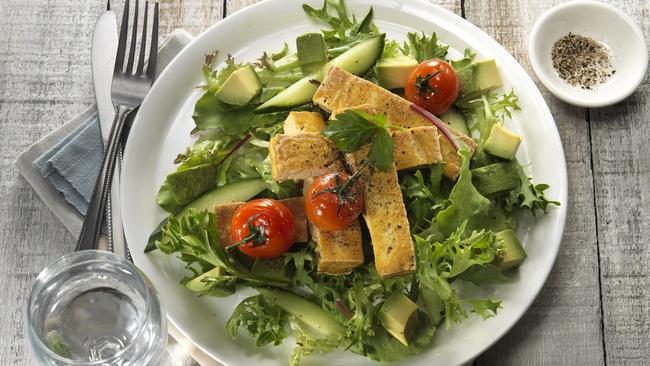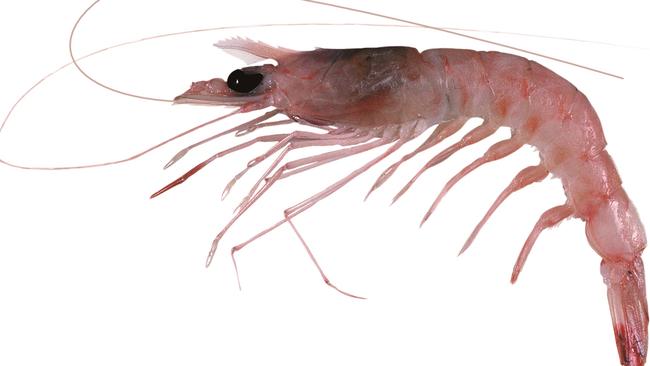New foods: rakia, chickpea tofu, camel milk, royal red prawns
Unlike quinoa and chia seeds, these hip new ingredients are actually tasty. Get into them before the hipsters do.

Fancy sitting down to a camel milk latte? Or how about a plate of royal red prawns with a side of chickpea tofu salad?
While our leaders debate global issues of sustainability and food security, there are innovators quietly creating and developing new products that may well be in all our pantries and bars before too long. Welcome to a few of our brave new foods.
Rakia. Rakia — the broad term for the feisty fruit brandy with origins in southeastern Europe including Greece, Croatia, Albania and Macedonia — is now being made and distilled in South Australia.
Brothers Jon and Con Lioulios have started producing the only contemporary rakia licensed and sold in Australia. It’s Called 36 Short, and they have made it in honour of their father, Pando — the name 36 Short comes from Pando’s suit size.
“Our father first brought the recipe from Macedonia to Australia over 50 years ago,” says Jon. “In his honour, we have brought to fruition our father’s dream of distilling a traditional rakia with a modern twist.”
The twist is in the distillation and refinement of the finished product. Traditionally, rakia is a strong and robust drink but the brothers have produced a “new world” 36 Short Gold Rakia and a White Rakia that focuses more on the smooth than the punchy, with the flavour more about nuances on the palate than powerful kicks.
Red wine grapes from McLaren Vale are the key ingredient in the making of 36 Short and the spirit works as an aperitif or digestive. “Traditionally, rakia is enjoyed neat before and after a meal, and can be accompanied with pickled vegetables and tapas, as well as cured and barbecued meats,” says Jon.
Of course, they have the cocktail boom in their sights. Their suggestion for bartenders everywhere: mix White Rakia with crushed ice, tonic water and fresh grapefruit juice.
36 Short Rakia is available online at www.36short.com.au and in Adelaide at Mr Goodbar, Thrift Shop Bar and The Edinburgh Hotel.

Chickpea tofu. Nathan Harris owns vegan and vegetarian food business Australian Eat Well, based in Victoria’s Wimmera mallee region, home to a strong legume farming industry. A few years back, Harris and his team had an idea: why not make tofu from something other than soybeans?
“For years we’ve produced an organic soy-based tofu; it seemed only logical to try to make tofu from another high-protein plant,” says Harris.
With the aim of sourcing a locally grown food from farmers in his surrounding area, Harris thought the most suitable choice to start with was chickpeas.
“We were also attracted to the idea of using chickpeas as they are a dry crop, do not require irrigation and the chickpea bush adds nitrogen naturally back into the soil, assisting in soil improvement.”
After three years of development trials, they reckon they’ve nailed their product. “There are some similarities in making both (soy and chickpea) products,” says Harris, “but we soon discovered it was not just a matter of following the same steps as making soy tofu.
“This presented quite a few challenges along the way but our persistence has paid off and we’re pretty proud of the result.”
And the flavour? It’s a little eggy, with a richness you don’t find with soy tofu: Harris says this egg flavour profile means it has potential to work in a scrambled tofu or tofu omelet. Chickpea tofu is vacuum sealed in a 250g packs and will be available in selected stores from next month. australianeatwell.com.au
Camel milk. Farmer Deb Corbett and her husband Stan bought 11 camels in 2006 for their property Bindanoon at Blackbutt in Queensland to help with weed control. Deb started to research camel milk and by 2009 began making soap from the milk the camels produced. They were pioneers. “There was no camel milk industry prior to us starting this,” she says.
Through her research, she discovered the health properties of camel milk — it has higher levels of protein, iron and vitamin C than cow’s milk — and now she makes and sells soaps, oils and balms online.
Corbett says demand for camel milk for human consumption has grown in Australia — it is a popular drink in North Africa, the Middle East and Asia — as “we have become more aware of camel milk and its topical healing properties”.
She adds, however, that it’s still a largely misunderstood commodity. “Many people do not realise that camels actually produce milk,” Deb says, “but they do — and have four teats, not two.”
Another odd misconception (or old wives’ tale) is that camels do not produce milk in the rain, but “they produce milk 24 hours a day as long as they have their baby with them”, she says.
Apart from cosmetic use, camel milk can be used like any other milk in tea, coffee, milkshakes and over your morning cereal. It’s slightly more watery than cow’s milk and has a saltier flavour.
The Corbetts’ milk is now used to produce camel milk and camel oil cosmetics, and while they are accredited by Safe Foods to produce camel milk, their pasteurised fresh milk is not available to the public yet, “pending infrastructure upgrades and additions”, says Deb Corbett.
If you’re keen to try camel milk, check out Camel Milk Victoria (camelmilkvictoria.com.au) or Australian Camel Dairies (gila73. wix.com/acdc )

Royal red prawns. Move over tiger and banana prawns — the royal red prawn is swimming up from the depths, literally. These deep-water prawns are found along Australia’s east coast and are being sold as royal red (though also sometimes as deep- water prawns).
Crispian Ashby of the Fisheries Research and Development Corporation says the prawns are considered sustainable by the NSW Department of Primary Industries and are generally caught by bottom trawling (often in mud) in depths of between 400m and 500m.
Royal red prawns are not cooked on board after they’re caught — as is often the case with tiger, banana or school prawns — so if buying them whole, look for vibrant shells and firm flesh. They are naturally pink in colour — unlike green prawns that become pink when cooked — and spoil quickly, so use them on the day of purchase or chop them up and freeze them. Because of this quick spoilage, royal red prawns are commonly sold peeled and frozen and are ideal for using chopped-up in curries, pastas and other dishes that don’t call for whole prawns to be used. A big bonus is the price — from as low as $10 a kilogram, compared with about $30/kg for the shallow-water varieties.
The mild flavour makes them perfect for prawn cakes and noodle dishes also — and the flesh is quite taut and muscular, given the lower temperatures they live in. Just don’t throw them on the barbie; their texture won’t stand up to the strong heat. Ask your fishmonger or market for the prawns: they’re available all year round but may be in the freezer rather than sold fresh.
